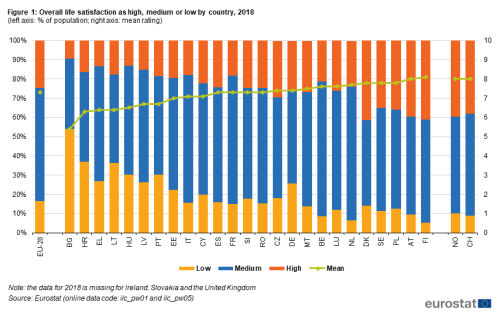Archive:Age of young people leaving their parental household
Data extracted in Month YYYY
Planned article update: Month YYYY
Highlights
Tweet Text
Tweet Text
<Interactive graph to be set by unit B4:>
or
or
The moving out from parental home is considered as a milestone in the transition from childhood to adulthood. The reasons behind this step may vary a lot - leaving the parental home to study or work, being materially independent, moving in with a partner or getting married and having children or not and so on. However, the path to independence may not be straightforward and happen, as will be shown below, at different age across countries. This difference may reflect the dissimilar challenges that young people face across Europe, as well as the variety of cultural particularities in the different countries.
Full article
Development over the years
Figure 1 indicates that in 2019, on average across the whole EU-27, young people did not leave the parental home until the age of 26.2 years. This average varies among the different EU countries. In Croatia, Slovakia, Italy and Bulgaria it was 30 years and over, whilst in Sweden, Luxembourg, Denmark and Finland it was less than 22. The lowest age of young people leaving their parental household was observed in Sweden - 17.8 years, and the highest in Croatia - 31.8 years. However, taking into account and non-EU countries, the highest age could be seen in Montenegro, where estimated age of young people leaving their parental household was 33.1 years on average.
Title
Text
Source data for tables and graphs
Data sources
<description of data sources, survey and data availability (completeness, recency) and limitations>
Context
<context of data collection and statistical results: policy background, uses of data>
Direct access to
Main tables
- Title(s) of second level folder (if any)
- Title(s) of third level folder (if any)
Database
- Title(s) of second level folder (if any)
- Title(s) of third level folder (if any)
Dedicated section
Publications
Publications in Statistics Explained (either online publications or Statistical articles) should be in 'See also' above
Methodology
<link to ESMS file, methodological publications, survey manuals, etc.>
- Crime and criminal justice (ESMS metadata file — crim_esms)
- Title of the publication
Legislation
- Use Eur-Lex icon on the ribbon tool at the top of the statistical article to enter the year and reference of your regulation or directive.
- See example of what should be issued hereafter
- Regulation (EU) No 1013/2016
Visualisations
- Regional Statistics Illustrated - select statistical domain 'xxx' (= Agriculture, Economy, Education, Health, Information society, Labour market, Population, Science and technology, Tourism or Transport) (top right)
External links
Notes
<footnote text will be automatically inserted if reference tags are used in article content text (use reference icon on ribbon)>
[[Category:<Subtheme category name(s)>|Name of the statistical article]] [[Category:<Statistical article>|Name of the statistical article]]
Delete [[Category:Model|]] below (and this line as well) before saving!
